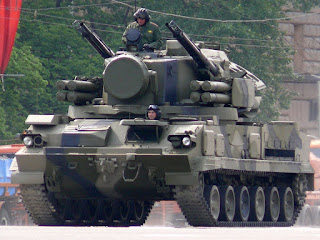The 2K22 Tunguska is a Russian tracked self-propelled anti-aircraft weapon armed with a surface-to-air gun and missile system. It is designed to provide day and night protection for infantry and tank regiments against low-flying aircraft, helicopters, and cruise missiles in all weather conditions. Its NATO reporting name is SA-19 "Grison".
 Development of the 2K22 anti-aircraft system began on 8 June 1970. At the request of the Soviet Ministry of Defense, the KBP Instrument Design Bureau in Tula, under the guidance of the appointed Chief Designer A. G. Shipunov, started work on a 30mm anti-aircraft system as a replacement for the 23mm ZSU-23-4.
Development of the 2K22 anti-aircraft system began on 8 June 1970. At the request of the Soviet Ministry of Defense, the KBP Instrument Design Bureau in Tula, under the guidance of the appointed Chief Designer A. G. Shipunov, started work on a 30mm anti-aircraft system as a replacement for the 23mm ZSU-23-4.
The project, code-named "Tunguska", was undertaken to improve on the observed shortcomings of the ZSU-23-4 (short range and no early warning) and a counter to new ground attack aircraft in development, such as the A-10 Thunderbolt II, which was designed to be highly resistant to 23 mm cannons. Studies were conducted and demonstrated that a 30 mm cannon would require from a third to a half of the number of shells that the 23 mm cannon of the ZSU-23-4 would need to destroy a given target, and that firing at a MiG-17 (or similarly at, in case of war, NATO's Hawker Hunter or Fiat G.91) flying at 300 m/s, with an identical mass of 30 mm projectiles would result in a kill probability 1.5 times greater than with 23 mm projectiles. An increase in the maximum engagement altitude from 2,000 to 4,000 m and increased effectiveness when engaging lightly armoured ground targets were also cited.
The initial requirements set for the system were to achieve twice the performance in terms of range, altitude and combat effectiveness of the ZSU-23-4, additionally the system should have a reaction time no greater than 10 seconds. Due to the similarities in the fire control of artillery and missiles, it was decided that the Tunguska would be a combined gun and missile system. A combined system is more effective than the ZSU-23-4, engaging targets at long-range with missiles, and shorter range targets with guns. More details
 Development of the 2K22 anti-aircraft system began on 8 June 1970. At the request of the Soviet Ministry of Defense, the KBP Instrument Design Bureau in Tula, under the guidance of the appointed Chief Designer A. G. Shipunov, started work on a 30mm anti-aircraft system as a replacement for the 23mm ZSU-23-4.
Development of the 2K22 anti-aircraft system began on 8 June 1970. At the request of the Soviet Ministry of Defense, the KBP Instrument Design Bureau in Tula, under the guidance of the appointed Chief Designer A. G. Shipunov, started work on a 30mm anti-aircraft system as a replacement for the 23mm ZSU-23-4.The project, code-named "Tunguska", was undertaken to improve on the observed shortcomings of the ZSU-23-4 (short range and no early warning) and a counter to new ground attack aircraft in development, such as the A-10 Thunderbolt II, which was designed to be highly resistant to 23 mm cannons. Studies were conducted and demonstrated that a 30 mm cannon would require from a third to a half of the number of shells that the 23 mm cannon of the ZSU-23-4 would need to destroy a given target, and that firing at a MiG-17 (or similarly at, in case of war, NATO's Hawker Hunter or Fiat G.91) flying at 300 m/s, with an identical mass of 30 mm projectiles would result in a kill probability 1.5 times greater than with 23 mm projectiles. An increase in the maximum engagement altitude from 2,000 to 4,000 m and increased effectiveness when engaging lightly armoured ground targets were also cited.
The initial requirements set for the system were to achieve twice the performance in terms of range, altitude and combat effectiveness of the ZSU-23-4, additionally the system should have a reaction time no greater than 10 seconds. Due to the similarities in the fire control of artillery and missiles, it was decided that the Tunguska would be a combined gun and missile system. A combined system is more effective than the ZSU-23-4, engaging targets at long-range with missiles, and shorter range targets with guns. More details
